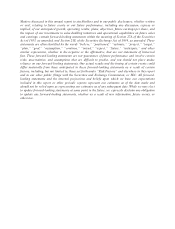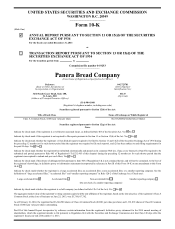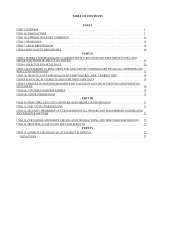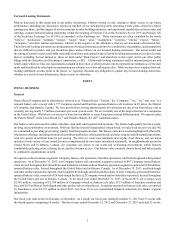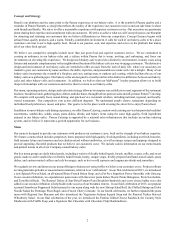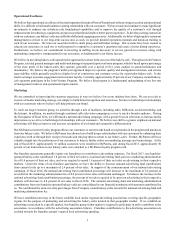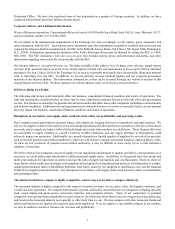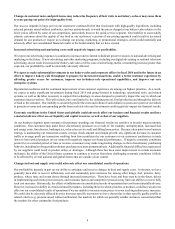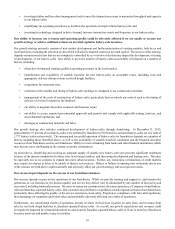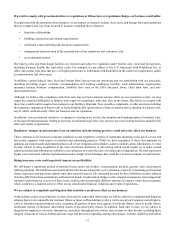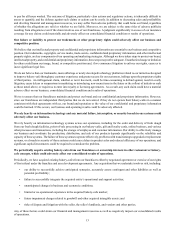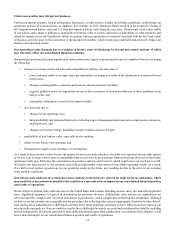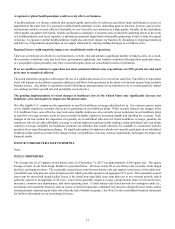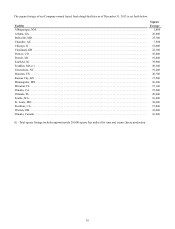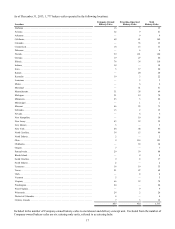Panera Bread 2013 Annual Report Download - page 16
Download and view the complete annual report
Please find page 16 of the 2013 Panera Bread annual report below. You can navigate through the pages in the report by either clicking on the pages listed below, or by using the keyword search tool below to find specific information within the annual report.8
Changes in customer tastes and preferences may reduce the frequency of their visits to our bakery-cafes or may cause them
to cease paying our prices for high-quality food.
Our success depends in large part on our customers' continued belief that food made with high-quality ingredients, including
selected proteins raised without antibiotics, and our artisan breads, is worth the prices charged at our bakery-cafes relative to the
lower prices offered by some of our competitors, particularly those in the quick-service segment. Our inability to successfully
educate customers about the quality of our food or our customers’ rejection of our pricing approach could result in decreased
demand for our products or require us to change our pricing, marketing, or promotional strategies, which could materially and
adversely affect our consolidated financial results or the brand identity that we have created.
Increased advertising and marketing costs could negatively impact our profitability.
We expect our advertising expenses to continue to increase and we intend to dedicate greater resources to national advertising and
marketing in the future. If new advertising and other marketing programs, including our digital advertising or national television
advertising, do not result in increased net bakery-cafe sales or if the costs of advertising, media, or marketing increase greater than
expected, our profitability could be materially adversely affected.
We expect to make substantial investments in our bakery-cafes and corporate offices in fiscal 2014 and in the future in an
effort to improve bakery-cafe throughput to prepare for increased transactions, enable a better customer experience by
affording greater access for customers, improve our in-bakery-cafe operational capabilities, and improve our core
enterprise systems.
Operational excellence and the continued improvement of our customer experience are among our highest priorities. As a result,
we expect to make significant investments during fiscal 2014 and going forward in technology, operational tools, and related
systems, as well as the labor necessary to support this technology, in areas designed to positively impact the way in which our
customers interact with us. This will include, but is not limited to, the ordering process, food production and through the delivery
of food to the customer. Our inability to accurately predict the costs and rollout of such initiatives across our system or our failure
to generate revenue and corresponding profits from such activities and investments could negatively impact our financial results.
Economic conditions in the United States and globally could adversely affect our business and financial results and have
a material adverse effect on our liquidity and capital resources as well as that of our suppliers.
As our business depends upon consumer discretionary spending, our financial results are sensitive to broader macroeconomic
conditions. Our customers may make fewer discretionary purchases as a result of, for example, unemployment, increased fuel
and energy costs, foreclosures, bankruptcies, reduced access to credit and falling home prices. Because a key point in our business
strategy is maintaining our transaction counts, average check amount and margin growth, any significant decrease in customer
traffic or average profit per transaction resulting from fewer purchases by our customers or our customers' preferences to trade
down to lower priced products on our menu will negatively impact our financial performance. If negative economic conditions
persist for an extended period of time or worsen, consumers may make long-lasting changes to their discretionary purchasing
behavior, including less frequent discretionary purchases on a more permanent basis. Additionally, financial difficulties experienced
by our suppliers could result in product delays or shortages. Although there has been some improvement in certain economic
indicators, the ability of the United States economy to continue to recover from these challenging economic conditions is likely
to be affected by several national and global factors that are outside of our control.
Changes in food and supply costs could adversely affect our consolidated results of operations.
Our profitability depends in part on our ability to anticipate and react to changes in food and supply costs. In the past, we have
generally been able to recover inflationary cost and commodity price increases for, among other things, fuel, proteins, dairy,
produce, wheat, tuna, and cream cheese through increased menu prices. There have been, and there may be in the future, delays
in implementing such menu price increases, and economic factors and competitive pressures may limit our ability to recover fully
such cost increases. Historically, the effects of inflation on our consolidated results of operations have not been materially adverse.
However, increased volatility in certain commodity markets, including those for wheat, proteins, or produce, could have an adverse
effect on our consolidated results of operations if we are unable to increase menu prices to cover such ingredient price increases.
We could also be adversely affected by price increases specific to proteins we have chosen due to their specific quality profile or
related criteria (e.g. proteins raised without antibiotics), the markets for which are generally smaller and more concentrated than
the markets for other commodity food products.


